Then<·>Now: Taiwan Experimental Film and Video Arts, Part 2
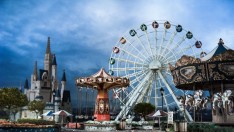
Tomorrowland 明日樂園 by Goang-Ming YUAN
Los Angeles Filmforum presents
Then<·>Now: Taiwan Experimental Film and Video Arts, Part 2
Sunday March 9, 2025, 7:30pm
At 2220 Arts + Archives, 2220 Beverly Blvd., Los Angeles CA 90057
DAYLIGHT SAVINGS TIME STARTS SUNDAY AT 2:00 am. Move your clocks forward one hour.
Multiple US and Los Angeles premieres!
Zoom Q&A after the screening with Yen-Chao LIN, Chun-Hui Tony Wu, and Tzu-An Wu. Moderated by programmer Cherlyn Hsing-Hsin Liu.
Tickets: $15 general, $10 students/seniors, free for Filmforum members
At: https://link.dice.fm/Ye0531f5c31e
Consistent with the first part of the series, Part 2 in our series focuses on "events": events in history, events outside of history, the moments when events are recorded, and the moments when events are screened, watched, and discussed. Communicating these events is like retelling history in a non-linear way. Some of the stories here are closely related to Taiwan, such as the life fragments of Kinmen soldiers in 03:04 by Ting-Fu Huang, while others revolve around the artist’s personal reflections, on migration, memory, and the symbiotic moments of life and cinema.
Around 1960, Taiwanese artists were inspired by the exchange of avant-garde cultures from around the world and began to develop a concept of modern experimental art. Many works created at that time had a profound impact on Taiwan's subsequent art culture. The achievements in modern experimental poetry, experimental theater, surrealism, and documentary photography are still important today, laying a solid foundation for Taiwanese avant-garde art.
Taiwan has a complicated history and a difficult geographical location. After World War II, in 1945, Japan ended its 50-year colonial rule over Taiwan. In 1949, the Chinese Civil War ended, and Chiang Kai-shek took his troops to Taiwan and began the Kuomintang (KMT)’s political rule. After 1990, Taiwan began the process of democratization and has been implementing the rotation of the ruling party up to the present day. In this wave of political changes, the most neglected are the indigenous people of Taiwan, and many stories about them have been left behind in the torrent of history.
Geographically located between China and Japan, many Taiwanese people chose to study in the West or encouraged their children to study in the West during the economic take-off era (1960s-1980s, known as the Taiwan Economic Miracle). After returning to Taiwan, this generation of students injected many new elements into Taiwan's modern art and academic research, especially in the areas of literature, painting, film, dance, and music.
Experimental films in Taiwan started around 1960 or even earlier. Many people found a connection with Dadaism or Surrealism, which opened a ray of hope for young students who had been oppressed by political history for a long time. They were full of disgust for war. They had also hoped to rebel against traditional aesthetics, breaking the traditions of China and Japan, and embracing modern art practices from across the world. With the continuous breakthroughs in photographic technology, coupled with the accessibility of equipment, many young Taiwanese artists have also joined the ranks of experimental filmmakers in recent years.
In form or in the application of language, the artists unreservedly or inevitably reflected the complexity of Taiwan's historical situation: marginality, obscurity, and multiple identities. Common techniques used in their works of art include allusion, symbolism, metaphor, and metonymy. It should be noted here that Taiwan experienced a period of White Terror (1949-1991) that lasted for more than 30 years when language use was relatively unsmooth or unfree (the Taiwanese people were forced to switch from Japanese, used during the colonial period, to Chinese). Today, freedom of daily language in Taiwan has been greatly improved, and it frequently interweaves Taiwanese, Chinese, Japanese, Korean, and English, thus giving rise to a kind of decolonization, defamiliarization, or entanglement.
As with many places around the world, experimental films have always been in a relatively marginal position. Compared with narrative films and traditional documentaries, experimental films are often ignored, misunderstood, or not understood. Therefore, these experimental film directors have few resources in Taiwan, and it is not unheard of that there are even no resources at all. During my curatorial research, I found that many early works were lost or not properly preserved. A large part of the reason is that these works have rarely had the opportunity to be screened since they were created, and only a very small number of works have received the attention of the government or academic research.
This ongoing research project, Then<·>Now: Taiwan Experimental Film and Video Arts, serves as a prelude, and its purpose is to allow these marginal experimental films to continue to be screened, viewed, and discussed, so that they can have the opportunity to circulate and be properly preserved.
The exhibition of Part One last November gave us hope. The 16mm print of Van Gogh's Ear that we screened is the only existing copy. After the screening, it aroused enthusiastic response and attention. Many people told us how precious it was to be able to see the film and then initiated efforts to preserve it. Fortunately, Van Gogh's Ear received the Lightpress digital preservation grant from the Interbay Cinema Society in Seattle, so the film, which is currently experiencing deterioration (it already has vinegar syndrome), will at least not face the misfortune of being completely lost. Thank you to everyone who helped make this mission possible!
This is a unique opportunity for us to screen these works together. Many of the works have never been shown in the United States, or at least this is their West Coast or Los Angeles premiere.
This event is made possible with the support of generous organizations including the Taiwanese United Fund (TUF) and the Taiwanese American Professionals-LA (TAP-LA). I would like to express special thanks to George Yin at TAP-LA and Chair of the Vincent Price Art Museum Foundation, Adam Hyman of Los Angeles Filmforum for their generous assistance, advice, and help, and finally, to Michael Pisaro-Liu for his generous support in many ways.
Program notes by Cherlyn Hsing-Hsin Liu.
Total Runtime: 70 minutes
Following the screening, the three filmmakers will participate in the discussion:
Chun-Hui Tony WU received his BFA with a major in Filmmaking at the San Francisco Art Institute and an MFA in Film/Video at Milton Avery Graduate School of the Arts, Bard College, New York. His experimental films experiment with and explore new concepts of found footage filmmaking, film reproduction, cross-film formats, and the integration of film and digital media within interdisciplinary art. They are adept at utilizing existing film celluloid and archival images, serving as channels for reconsidering the relationship between self, medium, and history. He is the author of “Stranger than Cinema: A Study of Taiwanese Experimental Film” and “West of Taiwan, East of Asia – A Study of Asian Experimental Film”.
Tzu-An WU works between experimental film and its expansions. He makes collages with analog films, through mixing heterogeneous images, audio, and texts in an attempt to inquire about the constructs of (cinematic) narratives and the selves. He holds an MA in Media Studies from The New School, New York, and a BA in Gender and Cultural Studies from NTHU, Taiwan.
Yen-Chao LIN is a Taipei-born Montreal-based multidisciplinary artist. Having grown up in a multifaith family, she is interested in religion, spirituality, divination arts, dowsing, occult sciences, alchemy, Feng Shui, oral tradition, and power - everything that can be sensed, but not necessarily seen. As a natural history enthusiast and an avid collector, Yen-Chao gathers specimens of mineral, botanical, animal and industrial origins, including objects that stare at the vestiges of a recent or distant past, with a story to tell. Through means of intuitive play, collaboration, scavenging and collecting, her tactile practice often incorporates various craft techniques, such as copper enameling, textile, and glass; creating installations, sculptures, and experimental films.

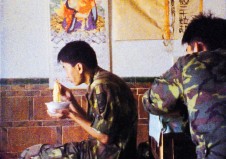
03:04
03:04
By Ting-Fu HUANG
2000, 16:00, Color, Sound, 16>35mm transferred to digital. US Premiere!
A quiet portrait of an island quietly existing through the gradual passage of nearly invisibly changing days. Animals wander in the streets, grass burns in the meadows, an empty village shop alternates with images of the everyday life of soldiers who are a bit bored and play pools, the echoes of which add rhythm to our observation.
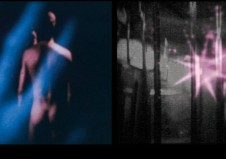
Yi-Ren (the person of whom I think) 伊人
Yi-Ren (the person of whom I think) 伊人
By Tzu-An WU
2015, 13:45, Color, Sound, S8mm transferred to digital. Los Angeles Premiere!
Yi-Ren (can be vaguely translated to “the person of whom I think”) is a collaged love letter from various sources. Such as my Super 8 diaries, karaoke videos, and found footage from Kang-Chien Chiu’s (1940-2013) films and poems. It is also an act of homage and a queer reading of Chiu. Reassemble, manipulate the materials, and melt the ready-made and the personal into one. Or, maybe the personal emotions and experiences are all borrowed from someone and somewhere… As the line “my moans have a bit of Hollywood in them” suggests, our emotions would not exist without acting, or movies we have seen.

Noah, Noah 諾亞諾亞
Noah, Noah 諾亞諾亞
(screening in 16mm)
by Chun-Hui WU
2003, 20:00, Color/B&W, Sound, S8mm/R8mm/16mm. US Premiere!
A lover in the past disclosed a life eroded by cancer in an e-mail. May 2003, plague and death expand. Noah sails once again on a journey without an end. Following Noah’s voyage, searching for the origin of memory and the infinite desire.
Collecting images. The image-memory in the home movies made for the past six years. The act of film-collecting has gradually become a desire to fetishize. Image-fetish, film-fetish and memory-fetish. Through the reproductive relation, such desire is transformed into a filmic act and experience.
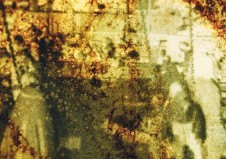
Cotton Sugar
Cotton Sugar
(screening in 16mm)
by Tsen-Chu HSU
2009, 3:20, Color, Silent, 16mm. Los Angeles Premiere!
By working with film as a medium, I have discovered a way to implement my interest in weaving both concepts and materials; integrating different elements into one work. In this piece, I covered the film with cotton and tinted it with dyes. The textures of cotton adhered to the film create a new layer; the original emulsion and the added textures coexist, cover and uncover each other at the same time. The differentials of color tones, the positive and negative footage, and the alternations of abstract and recognizable imagery introduce a dialogue about the possibilities of opposite characters. This is hand-processed film.

The Spirit Keepers of Makuta’ay
The Spirit Keepers of Makuta’ay
By Yen-Chao LIN
2018, 10:57, Color, Sound, S8mm transferred to digital. California Premiere!
Shot on location in the traditional Amis territory, The Spirit Keepers of Makuta’ay travels through villages on the east coast of Taiwan, where nature, colonization and population migration merge to create a unique spiritual landscape. The hand-processed Super 8mm film unravels mixed faith expressions from Daoist ritual possession to Presbyterian funeral, from personal prayers to collective resistance, all the while attempting to trace the memories of past Amis sorcerers.
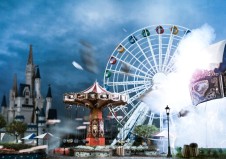
Tomorrowland 明日樂園
Tomorrowland 明日樂園
By Goang-Ming YUAN
2018, 4:46, Color, Sound, Installation to single-channel video. US Premiere!
An empty amusement park on a cloudy afternoon emerges on the screen. A castle reminiscent of Disneyland looms in the background. The amusement park seems closed; trees swaying and advertising flags gently flowing in the wind, litter blowing and rolling on the ground, and birds lingering in the air. The calm lasts for about a minute before the amusement park goes up in a sudden explosion.
